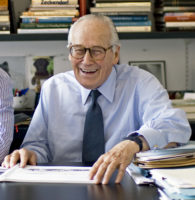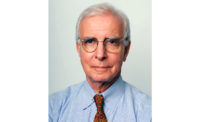A descendant of two Virginia-born presidents—James Madison and Zachary Taylor—Jaquelin T. Robertson was raised in a Georgian-style house near Richmond. There, he told the magazine Traditional Building in 2018, “You cared about houses, landscapes, gardens and fields, and you cared about public buildings, churches, courthouses, libraries and schools.”
Robertson continued to care about those things until his death on May 9. A renowned architect and planner, he started his career in New York City government, where his influence remains to this day: He helped create the system that encouraged developers to provide ground-floor amenities in exchange for the right to build additional square footage. Architect and author Robert A.M. Stern says that, as a result of Robertson’s work, it became “impossible to build a significant building in New York without serious consideration of its contributions to the city's urbanism.” His conclusion: “Jaque prevented New York from destroying itself.”
But his efforts extended far beyond New York. Robertson and his wife, Anya, lived in picture-perfect East Hampton, Long Island, and he helped create its simulacra in places like Celebration, the “all-American” small town developed by Disney near Orlando, and WaterColor, adjacent to Seaside in the Florida panhandle. He was associated with the New Urbanist movement, but the ideology he best represented was common sense. Ideas for cities could be evaluated by the “walk-around test,” he said. “If it won’t make you want to get out of your car and walk around, it’s a horrible idea.”

Robertson himself designed the Institute for the Arts & Humanities at the University of North Carolina at Chapel Hill, the Sony Pictures Imageworks Headquarters Building in Culver City, California, and numerous private residences, which in many cases his clients wouldn’t allow to be published. He was known for his extreme erudition and wit. "Every room he entered immediately became more elegant and welcoming,” said Jeff Speck, former director of design at the National Endowment for the Arts.
Robertson spent part of his childhood in China, where his father was stationed as an envoy. Later, as a Yale undergraduate, he studied politics but, he said in a 2011 interview, “I would spend much of my free time in the architecture school. Lou Kahn was teaching at the time, and I said to myself, 'Hell, I can do this. This is easy and interesting.' He described Vincent Scully, Josef Albers, and Philip Johnson, all of whom he met during those years, as mentors. After studying at Oxford as a Rhodes Scholar, he returned to Yale for graduate school in architecture."
Armed with an M.Arch., he entered public service. Working in the 1960s under New York City mayor John Lindsay, he and several other architects established the Urban Design Group within the City Planning Commission. Robertson became the first director of the Office of Midtown Planning and Development, a job he took because, as he said in a 2003 speech, he was “pissed off—excuse me, annoyed”—about the destruction of McKim, Mead & White’s Penn Station. It was in that role that he pushed developers to provide public amenities and shops at street level in return for extra floor area.
In the 1970s, he spent three years in Iran working for the Shah on plans for a (never-built) new district of Tehran. In 1980 he became dean of the University of Virginia School of Architecture. In 1982, he brought together a diverse group of 25 leading and emerging architects, including Paul Rudolph, Léon Krier, Tadao Ando, Toyo Ito, Frank Gehry, and Rem Koolhaas, for a symposium that later became a book entitled "The Charlottesville Tapes." While in Virginia, Robertson wrote a significant two-part treatise—“In Search of an American Urban Order”—applying Thomas Jefferson’s architectural principles to 20th century problems. He also helped steer the University’s own expansion toward the Jeffersonian. During his Virginia years, he was Peter Eisenman’s partner in the New York firm Eisenman/Robertson Architects. (“We never designed a building together,” says Eisenman, who described the partnership as more of a business arrangement, blessed by the profession’s power broker, Philip Johnson.) Robertson left Virginia and Eisenman to establish a new firm with his Yale classmate, Alex Cooper. Cooper/Robertson thrived, winning national AIA awards in both architecture and urban design.
"His lasting importance in the field," says Steven Semes, an architecture professor at the University of Notre Dame and former Cooper Robertson associate, "derives from his insistence that urban design and architecture are a single discipline, a spectrum of scales from the urban plan to the architectural detail. He would make a master plan for a new city and then fuss over the right light fixture to hang on one of the buildings."
Robertson, who retired from the firm in 2014, was devoted to its multidisciplinary approach. “Town planning and landscape and architecture and historic preservation are all inextricably connected,” he said. “You can’t have architecture without urbanism.”
Read a personal tribute on Jaquelin Robertson from Robert A.M. Stern.






